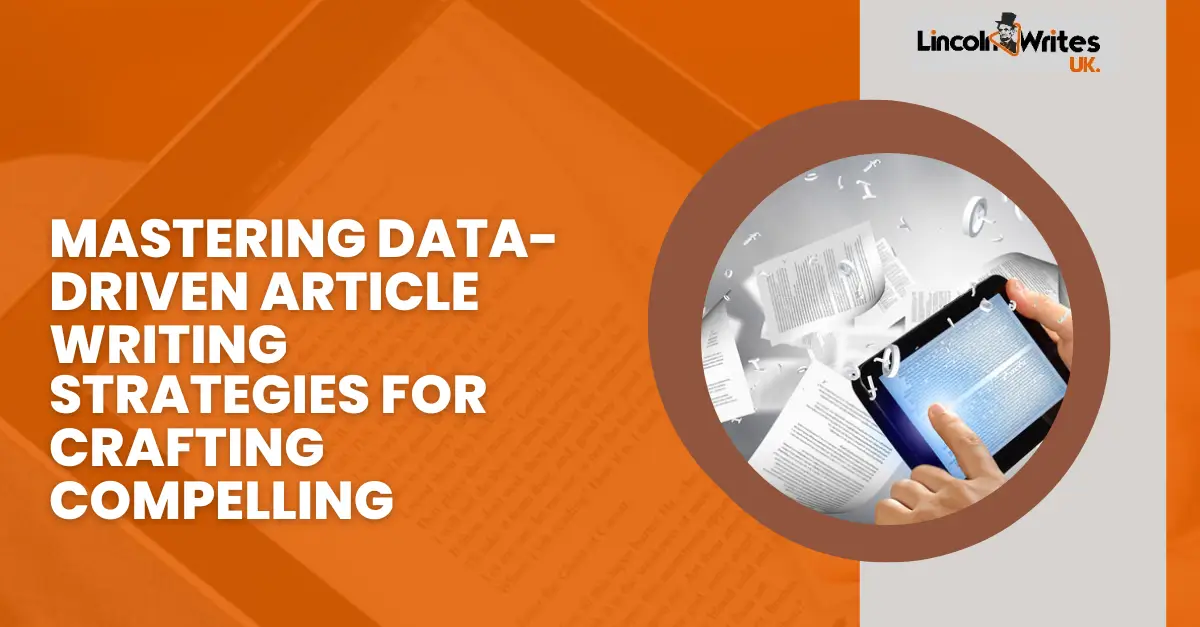In a world overflowing with content, what separates forgettable fluff from truly valuable writing? Data. Facts. Evidence. If you’re aiming to create high-impact blog posts, case studies, or thought leadership pieces, embracing data-driven article writing isn’t optional. It’s essential.
Done right, data-backed content builds trust, fuels SEO, and positions you as a credible voice in your niche. And if research, structure, and SEO make your eyes glaze over? That’s exactly where professional article writing services come in.
This guide will walk you through what it means to write with data, why it matters, and how to turn facts into stories your readers actually want to read.
Why Data Matters in Modern Content
Let’s start with the obvious: the internet is noisy. Thousands of articles go live every minute, many of them opinion-based or SEO-focused, without offering real value. But when you anchor your writing in research, statistics, and verified facts, you rise above the noise.
Data-driven article writing has several distinct advantages:
- Builds credibility with your audience
- Improves SEO by answering real, research-backed queries
- Supports conversion goals with persuasive evidence
- Attracts backlinks from other reputable sources
Whether you’re explaining memoir vs biography, unpacking business plan components startup founders should know, or showing authors how to optimise ebook formatting tools, data makes your argument stronger.
Step 1: Start with a Clear Topic and Purpose
Before gathering data, know what you’re writing and why. What’s the goal of the article? Who’s the audience? What action do you want readers to take?
A clearly defined purpose keeps your research focused and your writing sharp. If you’re supporting an author platform-building strategy, for instance, your goal might be to educate readers on publishing tips or writing best practices. If you’re promoting services, it might be to establish authority and build trust.
Step 2: Gather Credible Sources
Not all data is created equal. Readers (and search engines) can spot fluff a mile away. Use reliable sources such as:
- Academic journals
- Industry research reports
- Government databases
- Verified statistics platforms
- Reputable news outlets
Never rely on hearsay. And always check publication dates. Stale data is nearly as bad as no data.
For example, if you’re discussing book royalties in the UK, link to up-to-date royalty structures from UK publishers or industry organisations. If you’re writing about publishing prep, bring in stats about how many manuscripts get rejected due to querying literary agents’ mistakes, and back it up with a source.
Step 3: Use Data to Support, Not Distract
Data should enhance your narrative, not overwhelm it. Use stats sparingly and strategically. Too many numbers can make your article feel like a spreadsheet.
Think of each data point as a spotlight. Use it to shine attention on your main point, support your argument, or introduce a new idea.
For example, when explaining the importance of professional editing, referencing how many readers abandon books due to poor grammar could reinforce the value of line editing vs copyediting.
Step 4: Tell a Story With the Data
Facts tell. Stories sell.
Your data should drive a narrative. Connect the dots between stats and real-world impact. Use examples, case studies, or even analogies to humanise the numbers.
Take this: “82% of marketers use content marketing.”
Now make it meaningful: “That means nearly 9 out of 10 brands are publishing blogs, newsletters, or guides to attract and engage customers, leaving those without a content plan at a serious disadvantage.”
Whether you’re selling books or explaining the need for a ghostwriting contract, your audience wants a story they can relate to, not just a number.
Step 5: Make it Skimmable and SEO-Friendly
Structure matters. Use headers, short paragraphs, bolded takeaways, and strategic keywords.
If you’re planning a larger content plan tied to your brand content strategy, this structure will keep your posts consistent and easy to optimise.
Don’t forget your meta title, meta description, and internal linking. A good data-driven article writing plan should support both reader experience and search engine visibility.
Step 6: Add Visuals Where It Counts
Infographics, charts, and pull quotes can make your data more digestible. Visuals also increase time on page and social shareability, key engagement metrics for SEO.
If you’re working with complex topics, like outlining your autobiography structure or explaining how to collaborate with a children’s book illustrator, visuals can bridge the gap between idea and execution.
Step 7: Fact-Check and Update Regularly
Credibility hinges on accuracy. Double-check your sources, verify statistics, and attribute data properly. It’s also smart to revisit your evergreen content every 6–12 months to keep it fresh.
This is where outsourcing to article writing services can really shine. The best services include fact-checking, optimisation, and editorial polish as part of their package, so your content stays trustworthy and relevant.
Why Use Article Writing Services?
Here’s the thing: great content takes time. Researching, writing, optimising, and updating data-driven content can eat up hours (or days).
Professional services like Lincoln Writes UK:
- Save you time and stress
- Create SEO-optimised, on-brand articles
- Handle all fact-checking and formatting
- Tie content into your larger brand goals
- Help repurpose articles into evergreen blog topics, newsletters, or social posts
And if your content strategy includes book development, services can even help you choose a ghostwriter UK for long-form projects like lead magnets or book launches.
Where Data-Driven Content Fits in the Bigger Picture
You’re not writing in a vacuum. Every article should support your business objectives, enhance your brand voice, and connect with your audience’s needs.
A blog post about publishing might drive readers to your ebook formatting tools tutorial. A guide on memoir writing might link to your post comparing memoir vs biography. A piece on marketing might feed into your business plan components, startup resources.
It’s all connected, and when done right, it builds visibility, trust, and action.
Final Thoughts
Data-driven article writing is more than just citing a few statistics. It’s about crafting content that resonates, educates, and converts. Backed by research, built with purpose, and structured for SEO, data-driven content earns its keep long after it goes live.
And when you’re ready to take it to the next level, whether through article writing services, ghostwriting help, or collaborative publishing support, Lincoln Writes UK has your back.


